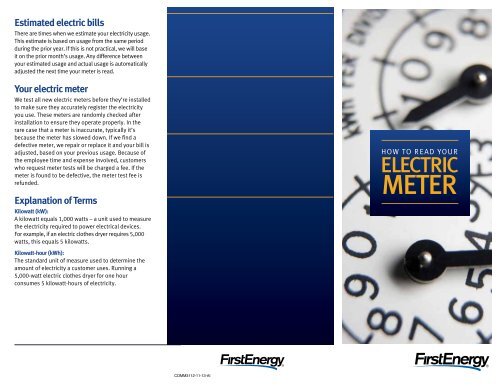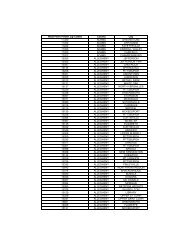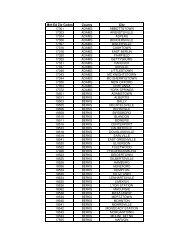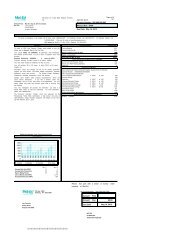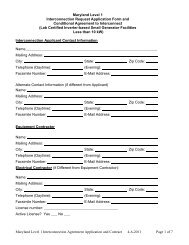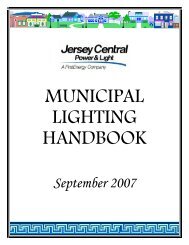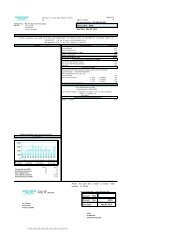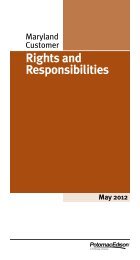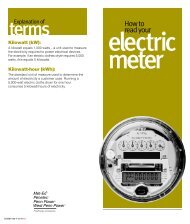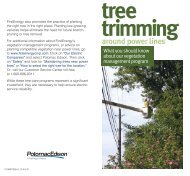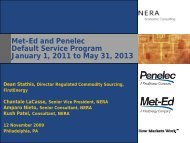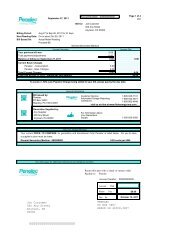How to Read Your Electric Meter - FirstEnergy
How to Read Your Electric Meter - FirstEnergy
How to Read Your Electric Meter - FirstEnergy
- No tags were found...
Create successful ePaper yourself
Turn your PDF publications into a flip-book with our unique Google optimized e-Paper software.
Estimated electric billsThere are times when we estimate your electricity usage.This estimate is based on usage from the same periodduring the prior year. If this is not practical, we will baseit on the prior month’s usage. Any difference betweenyour estimated usage and actual usage is au<strong>to</strong>maticallyadjusted the next time your meter is read.<strong>Your</strong> electric meterWe test all new electric meters before they’re installed<strong>to</strong> make sure they accurately register the electricityyou use. These meters are randomly checked afterinstallation <strong>to</strong> ensure they operate properly. In therare case that a meter is inaccurate, typically it’sbecause the meter has slowed down. If we find adefective meter, we repair or replace it and your bill isadjusted, based on your previous usage. Because ofthe employee time and expense involved, cus<strong>to</strong>merswho request meter tests will be charged a fee. If themeter is found <strong>to</strong> be defective, the meter test fee isrefunded.Explanation of TermsKilowatt (kW):A kilowatt equals 1,000 watts – a unit used <strong>to</strong> measurethe electricity required <strong>to</strong> power electrical devices.For example, if an electric clothes dryer requires 5,000watts, this equals 5 kilowatts.Kilowatt-hour (kWh):The standard unit of measure used <strong>to</strong> determine theamount of electricity a cus<strong>to</strong>mer uses. Running a5,000-watt electric clothes dryer for one hourconsumes 5 kilowatt-hours of electricity.<strong>How</strong> <strong>to</strong> read yourELECTRICMETERCOMM3112-11-13-AI
<strong>How</strong> <strong>Electric</strong> <strong>Meter</strong>sWORKYou can read your meter <strong>to</strong> determine your hourly,daily, weekly or monthly use.Stand directly in front of your electric meter, withthe meter at eye level. Most residential metershave four or five dials. Both types are read thesame way.Each dial on the meter is numbered from 0 <strong>to</strong> 9 andhas a pointer – like the hand on a clock – that turnseither clockwise or counterclockwise. The pointersadvance only when electricity is being used. Thesedials measure the number of kilowatt-hours (kWh)you use in 1s, 10s, 100s, 1,000s and 10,000s.To correctly read your meter, read the dials inorder, starting from the right and moving <strong>to</strong> theleft. Write down the numbers from right <strong>to</strong> left.In most cases, the pointer will be between twonumbers on the dial. The correct number is thelesser of the two.A typical reading is shown below:<strong>How</strong>ever, when the pointer appears <strong>to</strong> pointdirectly at a number, use that number only if thepointer on the dial <strong>to</strong> the right has passed 0.Otherwise, use the lesser number.E D C B ATens ofthousandsof kWhThousandsof kWhHundredsof kWhTensof kWhThe correct reading is 16839 kWhKilowatt-Hours(kWh)In the illustration above, the pointer on dial B appears<strong>to</strong> be pointing directly at the number 4. Becausethe pointer on dial A has not passed 0, the number4 on dial B should be read as 3.To figure the number of kilowatt-hours you usedduring the month, subtract the last month’s readingon your most recent bill from the present reading. Thiswill give the kilowatt-hours you used for the period.Follow these steps <strong>to</strong> determine your usage. The resultwill show how many kilowatt-hours of electricity youused and over what period you used them.1. Enter the meter reading you just <strong>to</strong>ok. ___________ kWh2. Enter the reading from the last timeyour meter was read.___________ kWh3. Subtract step 2 from step 1. = ___________ kWh4. Date you read the meter. ___________5. Date of previous reading. ___________6. Determine the number of daysbetween the dates of steps 4 and 5. ___________= Days between readings.<strong>Read</strong>ing your electric meter can tell you many things,such as the effect of a large new appliance on yourconsumption, how well you’re conserving energy, oreven the effect of the weather on your usage. You maywant <strong>to</strong> keep daily, weekly or monthly records.Tens ofthousandsof kWhThousandsof kWhHundredsof kWhTensof kWhThe reading is 23825 kWhKilowatt-Hours(kWh)


